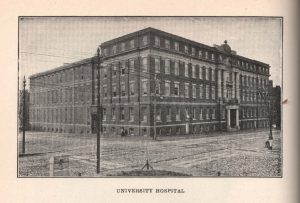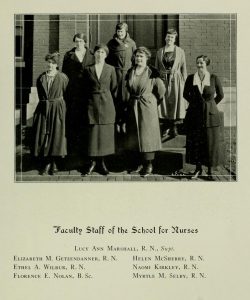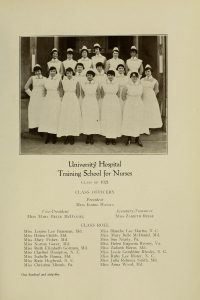The Health Sciences and Human Services Library Historical Collections’ strives to provide broad access to our diverse collections both in person and digitally. Materials in our collections appear as they originally were published or created and may contain offensive or inappropriate language or images and may be offensive to users. The University of Maryland, Baltimore does not endorse the views expressed in these materials. Materials should be viewed in the context in which they were created.

Photograph of the University Hospital, circa 1918. The hospital had 250 beds for patients. Image from Bulletin of the University of Maryland School of Medicine, July 1919.
The School of Nursing was founded in 1889 in the University of Maryland University Hospital. The school was under the leadership of a superintendent of nurses and was part of the School of Medicine. When the Maryland State College of Agriculture (College Park) and the University of Maryland (Baltimore) merged in 1920, the School of Nursing became its own entity but remained under the administrative control of the University Hospital.
From May 1919 to October 1920, the school experienced significant leadership turnover as five different superintendents were named and quickly replaced over eighteen months. Finally, Lucy Marshall became Superintendent on October 15, 1920 and remained for almost two years. Marshall was replaced by Annie Creighton on July 1, 1922. Creighton brought significant changes and stability to the school; she increased classroom instruction, introduced a five-year academic program (the first class graduated in 1934), and opened a new nurses’ building, which was being planned and money was being raised during the 1920-1921 academic year. The building opened in November 1922 and was named Parsons Hall after Louisa Parsons, the school’s first superintendent.
In addition to a new superintendent of nurses in the University Hospital, the school during the 1920-1921 academic year was trying to meet the mounting demand for nurses resulting from World War I and the 1918 Flu Epidemic. In December 1920, the school accepted 63 nursing students to help meet this demand. However, the nursing shortage would continue to be an issue well into the 1920s. In addition to the scarcity of nurses, opportunities within the profession were expanding. According to the first volume of the School of Nurses’ Alumnae Bulletin in April 1921 new opportunities for nursing graduates included positions as instructor, superintendent, public health nurse, community nurse, industrial nurse, institutional nurse, social service nurse, and other special duties. These positions represented a change from years prior where a nursing graduate could either be employed in a hospital or special duty; neither of which offered good pay or schedule.
Students interested in attending the school of nursing had to apply in person at the University Hospital or by letter to the Superintendent of Nurses. All applications needed to include a statement of good moral character from a clergyman, a statement of sound health and unimpaired faculties from a physician and show proof of a high school education or its equivalent. Additionally, to qualify for admission, students needed to be between the ages of 18 and 35; the school of nursing was the only one within the University of Maryland to have a maximum age for admission. Like the other schools in the University, African American students were not accepted until the 1950s because of the 1896 Supreme Court Decision, Plessy vs. Ferguson. However, unlike the other schools, the school of nursing was exclusively female students. The first male graduate was Hector Cardellino, Class of 1961.
Unlike the other schools and departments at the University of Maryland, the SON’s academic calendar began in February and ended in September. Nursing students spent their first of three years on probation and were on duty for six to eight hours daily that year. They received board, laundry, and lodging free of charge and were also supplied with textbooks and hospital uniforms after their probationary period. Additionally, students were paid a $5 per month salary. Instruction was given by head nurses as well as faculty from the medical and nursing schools. Each year students were given written and oral exams.
The schedule for student nurses was rigorous, by the third year, students were expected to be on duty for twelve hours daily. Martha Mallon, class of 1913 in a 1956 interview remembers just how difficult the schedule was:
Working shifts were twelve hour duty, seven to seven with one-half day off per week. The student working day was relieved three hours during her shift by her senior. She compulsively attended classes October through May. The Superintendent of Nurses taught theory, anatomy to pharmacology and the Assistant Superintendent taught nursing arts and skills, demonstrating on the ward patient….Evenings were short. Class, homework, studying and reading occupied much of the off duty time.[1]
Perhaps an indication of the difficulty of the schedule and coursework is the relatively small size of the Class of 1921. In May 1921, the school of nursing graduated only 18 nurses.
For more information on the SON in 1920 see:
- 1921 Terra Mariae Yearbook
- 1921 SON Alumnae Bulletin
- SON Living History Museum Virtual Tour
- 1921 SOM Academic Catalog
- Innovation in Action: The University of Maryland School of Nursing From Its Founding in 1889 to 2012 Book
[1] From School of Nursing’s Living History Museum Virtual Tour, available here: https://www.nursing.umaryland.edu/museum/virtual-tour/foundation/early-years/



